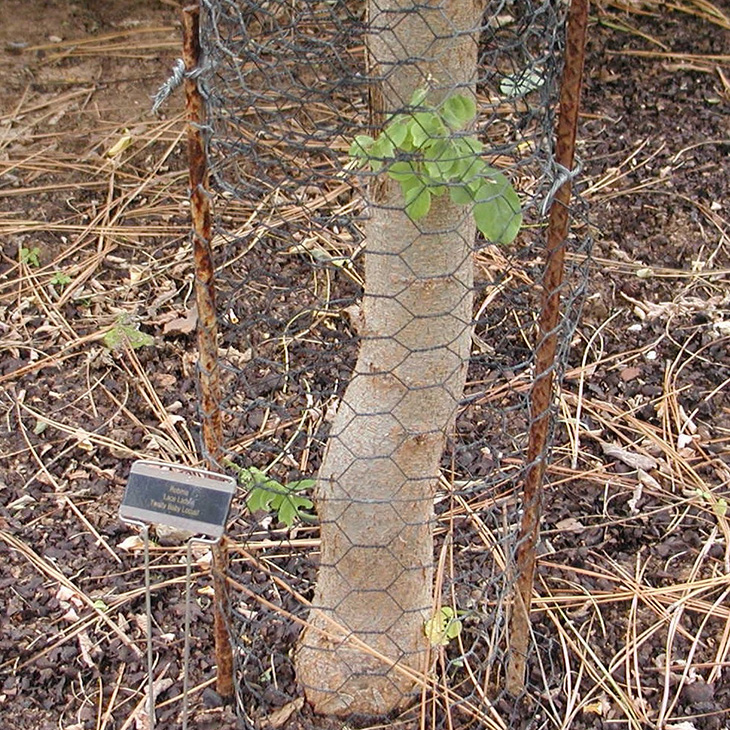
Deer proofing can help preserve your landscape
Friday, September 7, 2018
When the crisp fall air arrives, many people find themselves spending more time outdoors. Not only do Oklahomans enjoy fall activities such as high school and college football, roasting hotdogs over a firepit or evening walks around the neighborhood, many begin to add more color to the landscape with a variety of fall plants.
However, some of this landscape material is not only attractive to humans, but to wildlife as well – especially white-tailed deer. When the weather begins to cool down, wildlife may be looking for a food source as natural vegetation begins to die back, said David Hillock, Oklahoma State University Cooperative Extension consumer horticulturist.
“As deer begin to move into an area, homeowners initially enjoy seeing them in their landscape. In fact, some may even encourage deer to come into their yards,” Hillock said. “However, their attitude likely changes once their trees and shrubs begin to show damage and fall gardens become more difficult to grow because of continued browsing by the wildlife. Deer, especially can be the culprit for uprooted plants, stripped branches on trees and shrubs and damaged bark on trees.”
One of the best ways to avoid, or at least cut down on potential damage, is to make your landscape less attractive to deer by installing deer-resistant plants. These plants are unappetizing to those curious critters, which allows homeowners to create a stunning landscape display that will allow the leaves and flowers to reach their full potential.
Like humans, deer consume a wide variety of plants to meet their nutritional needs. They have a varied diet that includes many broadleaf herbaceous and woody plants. They are not considered grazers, like cattle, but more along the lines of browsing animals. Their preferred diet includes shrubs, young trees and vines.
“One reason deer damage is so noticeable is because they have no upper incisors. They feed by tearing vegetation with their lower incisors and upper palate,” he said. “Deer damage is easily identified by the jagged remains of browsed plant material. Annuals are often pulled completely out of the ground.”
Eating plants is not the only way deer can cause damage in the landscape. Damage also may occur in the fall when bucks begin rubbing antlers on small trees or other young landscape plants.
Hillock said the problem of damage control is not an easy one to solve. Some of the deer-resistant garden plants include cantaloupe, cucumber, eggplant, watermelon, tomato, onion and hot peppers. Annual herbaceous flowers in which deer tend to leave alone include amaranth, cosmos, French marigold, heliotrope, lantana, periwinkle, salvia, signet marigold, snapdragon and zinnia, to name a few.
When choosing herbaceous perennial flowers, consider bee balm, flax, foxglove, lamb’s ears, lavender, primrose, ragwort, rosemary, sage, thyme, toad lily, iris, goldenrod and shasta daisy, among others.
Safe bets among woody plants include buckthorn, Chinese junipers, dogwoods, Chinese holly, honey locust, Japanese flowering cherry, various pines, American holly, ginkgo, sumac, yucca, loblolly pine, dwarf Alberta spruce, boxelder and common boxwood.
“Aside from installing plants, shrubs and trees deer don’t like, there are other methods to keeping them out of your landscape. Probably the most effective way is physical exclusion. However, this may not always be possible,” he said. “Deer can easily jump over many decorative fences. Unfortunately, electric fences or an eight-foot deer fence may not blend in with your landscape. Also, fencing can be quite expensive if you have a large yard.”
If your property butts up to a wooded area, Hillock suggests installing the fence along the tree line.
To help protect the tender bark of young trees, homeowners may want to consider using wire cages around the trunks. Be sure to support the cages securely by using metal posts.
There are a number of scare tactics homeowners can use to frighten deer away from the landscape. Dogs are quite effective at repelling deer. Homeowners also may consider installing an invisible dog fence. Invisible dog fences (underground containment systems) can be used so dogs can see and harass deer. However, frequent barking may become more of a nuisance than the deer.
“Products that make a lot of noise, such as propane gas exploders, or something like a strobe light or even a radio, can scare the deer away,” Hillock said. “Unfortunately using loud noises are not only disturbing to deer, but to the homeowner and neighbors. Thus, it is not typically useful for the home gardener. Another device is a motion-activated sprinkler in the garden that’s triggered when deer enter the space. While scare tactics aren’t necessarily long-lasting, they may be useful long enough for you to harvest your garden crop before the deer do it for you.”
Repellents are another option. Those that have demonstrated the best results are thiram-based contact repellents such as Chaperone and Spotrete-F, along with repellents made with putrescent egg solids.
While repellents can reduce damage, they won’t eliminate it. If food sources are scarce, deer will eat about anything. Effectiveness of repellents will vary with deer density, palatability, availability of alternate food sources and the season. Many repellents don’t weather well and need to be reapplied following a rain.
“Your best bet is to combine judicious selection of plants with other control methods,” Hillock said. “This should provide the rural or suburban homeowners with some realistic means of damage reduction. Keep in mind, however, it’s a good idea to begin control measures before significant damage occurs.”
Story by Trisha Gedon
